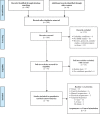Brain Activities Responding to Acupuncture at ST36 (zusanli) in Healthy Subjects: A Systematic Review and Meta-Analysis of Task-Based fMRI Studies
- PMID: 35968313
- PMCID: PMC9373901
- DOI: 10.3389/fneur.2022.930753
Brain Activities Responding to Acupuncture at ST36 (zusanli) in Healthy Subjects: A Systematic Review and Meta-Analysis of Task-Based fMRI Studies
Abstract
Purpose: Stomach 36 (ST36, zusanli) is one of the important acupoints in acupuncture. Despite clinical functional magnetic resonance imaging (fMRI) studies of ST36 acupuncture, the brain activities and the neural mechanism following acupuncture at ST36 remain unclear.
Methods: Literature searches were conducted on online databases, including MEDLINE, Embase, Cochrane Library, Web of Science, China National Knowledge Infrastructure, Wanfang database, WeiPu database, and China Biology Medicine, for task-based fMRI studies of acupuncture at ST36 in healthy subjects. Brain regions activated by ST36 acupuncture were systematically evaluated and subjected to seed-based d mapping meta-analysis. Subgroup analysis was conducted on control procedures, manual acupuncture, electrical acupuncture (EA), and acupuncture-specific activations. Meta-regression analysis was performed to explore the effects of needle retention time on brain activities following ST36 acupuncture stimulation. The activated brain regions were further decoded and mapped on large-scale functional networks to further decipher the clinical relevance of acupuncturing at ST36.
Results: A total of sixteen studies, involving a total of 401 right-handed healthy participants, that satisfied the inclusion criteria were included in the present meta-analysis. Meta-analysis showed that acupuncturing on ST36 positively activates the opercular part of the right inferior frontal gyrus (IFG.R), left superior temporal gyrus (STG.L), and right median cingulate/paracingulate gyri (MCG.R) regions. Needle retention time in an acupuncture session positively correlates with the activation of the left olfactory cortex, as shown in meta-regression analysis. Subgroup analysis revealed that EA stimulation may be a source of heterogeneity in the pooled results. Functional network mappings showed that the activated areas were mapped to the auditory network and salience network. Further functional decoding analysis showed that acupuncture on ST36 was associated with pain, secondary somatosensory, sound and language processing, and mood regulation.
Conclusion: Acupuncture at ST36 in healthy individuals positively activates the opercular part of IFG.R, STG.L, and MCG.R. The left olfactory cortex may exhibit positive needle retention time-dependent activities. Our findings may have clinical implications for acupuncture in analgesia, language processing, and mood disorders.
Systematic review registration: https://inplasy.com/inplasy-2021-12-0035.
Keywords: ST36 (zusanli); acupuncture; brain activation; systematic review; task-based fMRI.
Copyright © 2022 Huang, Yue, Huang, Long, Kang, Rao, Zeng, Zuo, Wang, Li, Wang, Qiu and Zhao.
Conflict of interest statement
The authors declare that the research was conducted in the absence of any commercial or financial relationships that could be construed as a potential conflict of interest.
Figures




Similar articles
-
[Brain regions responding to acupuncture stimulation of Zusanli (ST36) in healthy subjects analyzed on the basis of spontaneous brain activity].Zhen Ci Yan Jiu. 2019 Jan 25;44(1):66-70. doi: 10.13702/j.1000-0607.180138. Zhen Ci Yan Jiu. 2019. PMID: 30773866 Chinese.
-
A systematic review and coordinate-based meta-analysis of fMRI studies on acupuncture at LR 3.Front Neurosci. 2024 Jan 29;18:1341567. doi: 10.3389/fnins.2024.1341567. eCollection 2024. Front Neurosci. 2024. PMID: 38348133 Free PMC article.
-
Effect of acupuncture on brain regions modulation of mild cognitive impairment: A meta-analysis of functional magnetic resonance imaging studies.Front Aging Neurosci. 2022 Sep 23;14:914049. doi: 10.3389/fnagi.2022.914049. eCollection 2022. Front Aging Neurosci. 2022. PMID: 36212046 Free PMC article.
-
Cerebral activation effects of acupuncture using Zusanli (ST36) and Yanglingquan (GB34) points based on Regional Homogeneity indices: A resting-state fMRI study.J Xray Sci Technol. 2016;24(2):297-308. doi: 10.3233/XST-160557. J Xray Sci Technol. 2016. PMID: 27002910
-
Functional magnetic resonance imaging studies of acupuncture at ST36: a coordinate-based meta-analysis.Front Neurosci. 2023 Jun 9;17:1180434. doi: 10.3389/fnins.2023.1180434. eCollection 2023. Front Neurosci. 2023. PMID: 37360179 Free PMC article. Review.
Cited by
-
Objectivization study of acupuncture Deqi and brain modulation mechanisms: a review.Front Neurosci. 2024 May 3;18:1386108. doi: 10.3389/fnins.2024.1386108. eCollection 2024. Front Neurosci. 2024. PMID: 38765671 Free PMC article. Review.
-
Acupuncture with twirling reinforcing and reducing manipulation shows a control of hypertension and regulation of blood pressure-related target brain regions in spontaneously hypertensive rat: a preliminary resting-state functional MRI study.Front Neurosci. 2023 May 26;17:1161578. doi: 10.3389/fnins.2023.1161578. eCollection 2023. Front Neurosci. 2023. PMID: 37304030 Free PMC article.
-
Exploring acupuncture as a therapeutic approach for tic disorders: a review of current understanding and potential benefits.Front Neurol. 2025 Mar 14;16:1447818. doi: 10.3389/fneur.2025.1447818. eCollection 2025. Front Neurol. 2025. PMID: 40162008 Free PMC article. Review.
-
How You Treat Hemorrhoids with Acupuncture and/or Chinese Herbs, in Your Practice.Med Acupunct. 2024 Oct 21;36(5):299-300. doi: 10.1089/acu.2024.0145. eCollection 2024 Oct. Med Acupunct. 2024. PMID: 39741765 No abstract available.
-
Efficacy and brain modulation mechanisms of acupuncture for chronic prostatitis/chronic pelvic pain syndrome revealed by structural MRI changes.Front Neurol. 2025 Jun 25;16:1579484. doi: 10.3389/fneur.2025.1579484. eCollection 2025. Front Neurol. 2025. PMID: 40635711 Free PMC article.
References
Publication types
LinkOut - more resources
Full Text Sources

